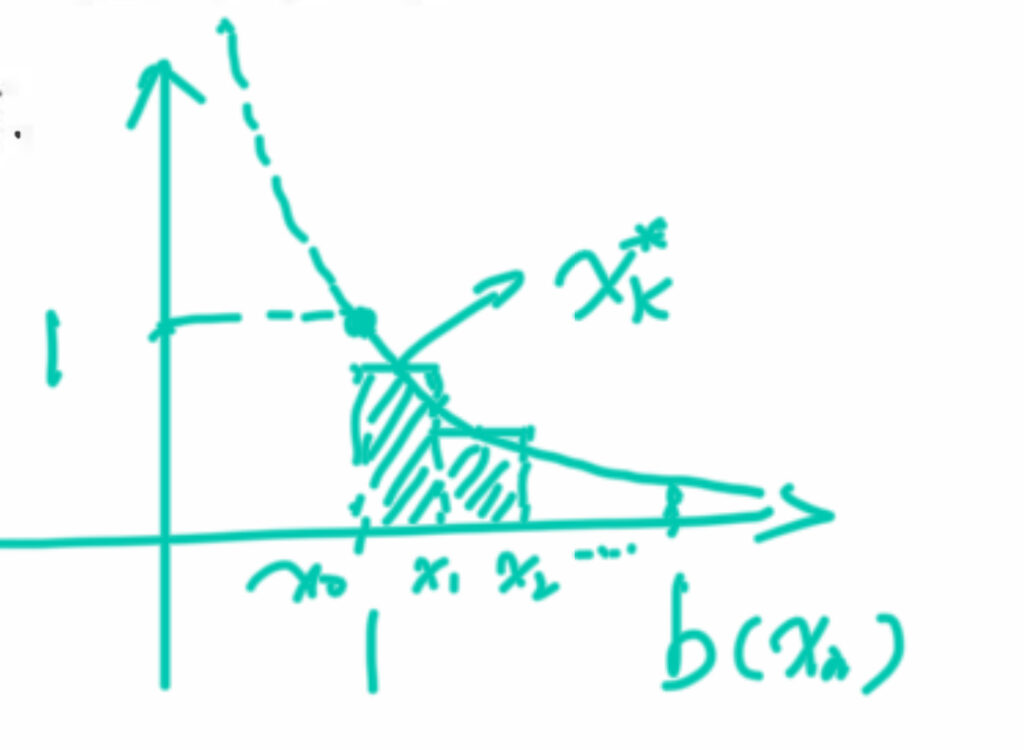这是定积分原理推导的第二道题目,先看英文原题:
show that$$\int _{1}^{b}\dfrac{1}{x^{2}}dx=1-\dfrac{1}{b}$$by using equal subintervals and taking $x_{k}^{\ast }=\sqrt{x_{k-1}\cdot x_{k}}$ in formula (12) of Section 6.4(同第一题中所指公式)。
还是一样,先画出草图

首先,根据定积分的定义以及题意,可知将1和b之间分成n等份,由此将该曲线与x轴之间的面积分成n个长方形。
得到每个长方形的底边(也就是每等份之间隔)为$\dfrac{b-1}{n}$,为了方便起见,我们将$\dfrac{b-1}{n}$记为$m$
再用 $m$ 分别表示$x_{0}$、$x_{1}$、$x_{n}$等
$$\begin{aligned}x_{0}&=1\ \\
x_{1}&=1+m\ \\
x_{2}&=1+2m\ \\
\vdots \ \\
x_{n}&=1+nm=b\end{aligned}$$
再根据题目之要求,taking $x_{k}^{\ast }=\sqrt{x_{k-1}\cdot x_{k}}$ in formula (12) of Section 6.4,得到
$$\begin{aligned}x_{1}^{\ast }&=\sqrt{x_{0}\cdot x_{1}}=\sqrt{1\cdot \left( 1+m\right) }\ \\
x_{2}^{\ast }&=\sqrt{x\cdot x_{2}}=\sqrt{\left( 1+m\right) \cdot \left( 1+2m\right) }\ \\
\vdots \ \\
x_{n}^{\ast }&=\sqrt{x_{n-1}\cdot x_{n}}=\sqrt{\left[ 1+\left( n-1\right) m\right] \cdot \left( 1+nm\right) }\end{aligned}$$
再根据$f\left( x\right) =\dfrac{1}{x^{2}}$,得到每个长方形的高:
$$\begin{aligned}f\left( x_{1}^{\ast }\right) &=\dfrac{1}{1\cdot \left( 1+m\right) }\ \\
f\left( x_{2}^{\ast }\right) &=\dfrac{1}{\left( 1+m\right) \cdot \left( 1+2m\right) }\ \\
\vdots \ \\
f\left( x_{n}^{\ast }\right) &=\dfrac{1}{\left[ 1+\left( n-1\right) m\right] \cdot \left( 1+nm\right) }\end{aligned}$$
再计算得到每个长方形之面积如下:
$$\begin{aligned}S_{1}&=f\left( x_{1}^{\ast }\right) \cdot m=\dfrac{1}{1\cdot \left( 1+m\right) }\cdot m\ \\
S_{2}&=f\left( x_{2}^{\ast }\right) \cdot m=\dfrac{1}{\left( 1+m\right) \cdot \left( 1+2m\right) }\cdot m\ \\
\vdots \ \\
S_{n}&=f\left( x_{n}^{\ast }\right) \cdot m=\dfrac{1}{\left[ 1+\left( n-1\right) m\right] \cdot \left( 1+nm\right) }\cdot m\end{aligned}$$
原题中还有一个提示,可以直接帮助解决这个求和问题:
Hint: It will be necessary to use a variation of the idea behind the formula$$\begin{aligned}\dfrac{1}{1\cdot 2}+\dfrac{1}{2\cdot 3}+\ldots +\dfrac{1}{\left( n-1\right) n}\
&=\dfrac{1}{1}-\dfrac{1}{2}+\dfrac{1}{2}-\dfrac{1}{3}+\ldots -\dfrac{1}{n}\ \\
&=1-\dfrac{1}{n}\end{aligned}$$
在此,稍加注意:$$\begin{aligned}\dfrac{1}{1}-\dfrac{1}{1+m}&=\dfrac{1+m-1}{1\cdot \left( 1+m\right) }\ \\
&=\dfrac{m}{1\cdot \left( 1+m\right) }\end{aligned}$$
从而很容易得出所有长方形的面积之和为:$$\begin{aligned}S_{sum}&=S_{1}+S_{2}+\ldots +S_{n}\ \\
&=\dfrac{1}{1}-\dfrac{1}{1+m}+\dfrac{1}{1+m}-\dfrac{1}{1+2m}+\ldots -\dfrac{1}{1+nm}\ \\
&=1-\dfrac{1}{1+nm}\end{aligned}$$
最后将上式中的 $m$ 替换为 $\dfrac{b-1}{n}$ 得到:
$$\begin{aligned}1-\dfrac{1}{1+nm}=\dfrac{nm}{1+nm}&=\dfrac{b-1}{b}\ \\
&=1-\dfrac{1}{b}\end{aligned}$$
证毕